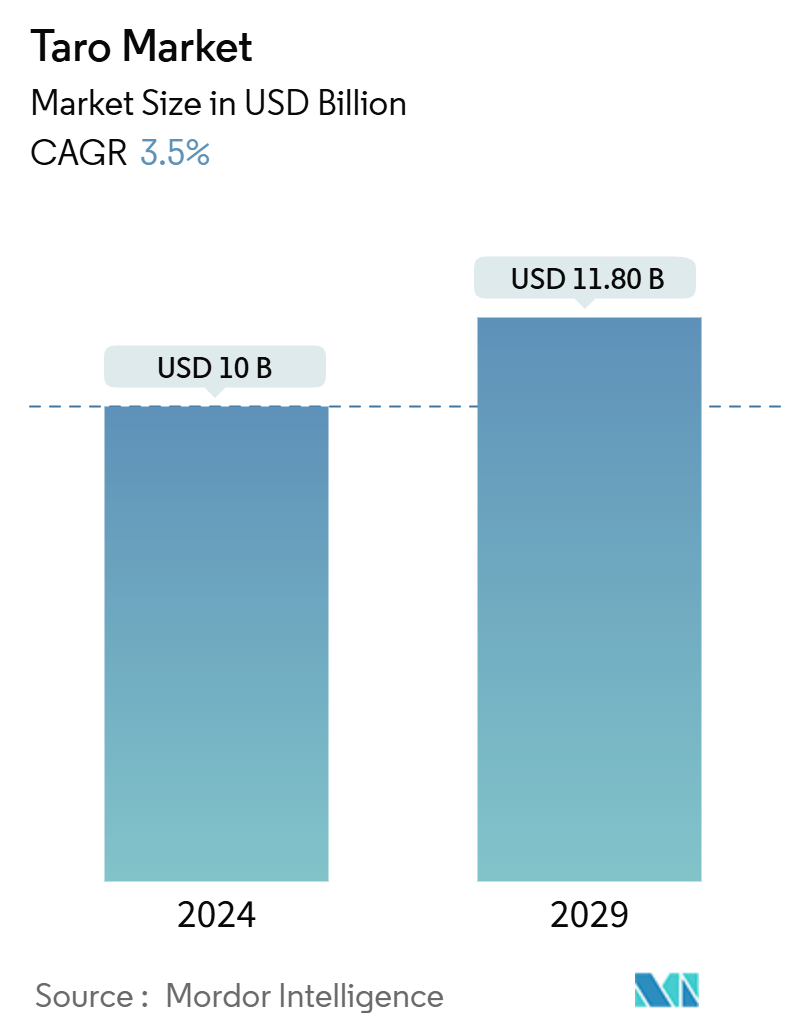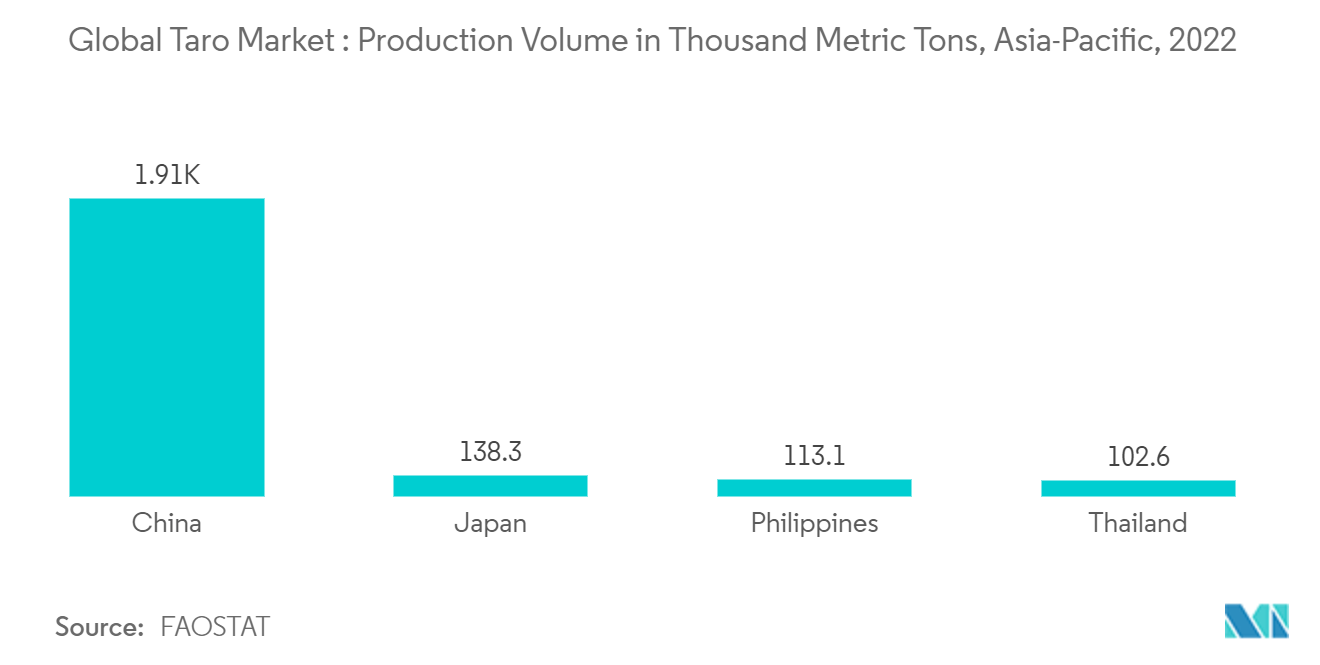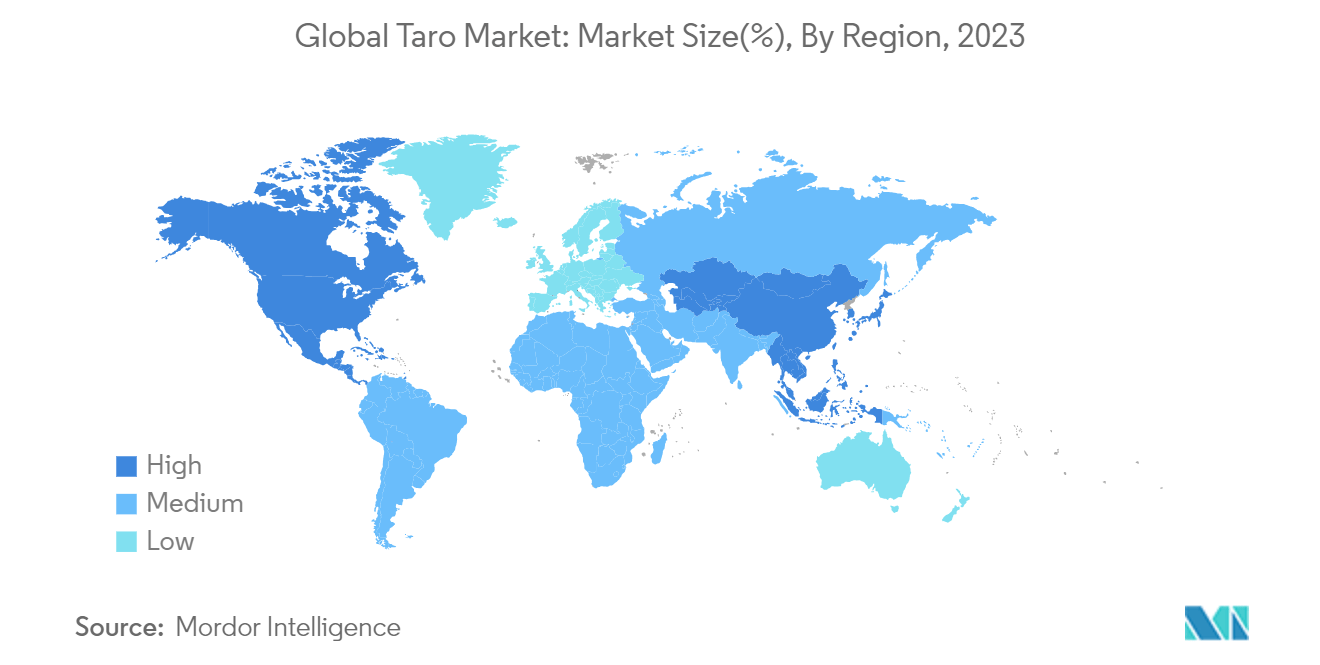Taro Market Size

| Study Period | 2019 - 2029 |
| Market Size (2024) | USD 10 Billion |
| Market Size (2029) | USD 11.80 Billion |
| CAGR (2024 - 2029) | 3.50 % |
| Fastest Growing Market | Asia Pacific |
| Largest Market | North America |
Taro Market Overview
The Taro Market size is estimated at USD 10 billion in 2024, and is expected to reach USD 11.80 billion by 2029, at a CAGR of 3.5% during the forecast period (2024-2029).
Taro (Colocasia esculenta) is a traditional crop with significant nutritional and pharmaceutical potential compared to other tuber crops. Various parts of the taro plant contain bioactive compounds including tarin, polysaccharides (TPS1 and TPS2), alkaloids, polyphenols, and saponins. These compounds have demonstrated anti-carcinogenic, anti-compulsive, anti-hyperglycemic, anti-hypertensive, anti-inflammatory, hepatoprotective, immunoprotective, and neuroprotective properties. Taro is rich in carbohydrates and serves as a viable alternative to wheat flour. It is known for producing reasonable yields in poor soil conditions with minimal or no farm inputs, making it a valuable crop for resource-limited farmers. As a result, taro is considered an important source of food security, which is anticipated to drive market growth during the coming years.
Taro possesses unique characteristics that position it as a promising crop for the future. These include small-sized starch granules, resistant starch type, and hypoallergenic properties. Poi, a traditional taro product, is known for its medicinal properties. Other processed taro products include flour, cookies, noodles, and achu. Due to its easy digestibility, taro is also a significant ingredient in baby food products. The documented traditional uses of taro in rural communities and the quantification of its bioactive compounds highlight its potential as a functional food and in pharmaceutical development.
Taro, the most widely cultivated species in the Araceae family, is primarily used as a vegetable. Major import markets include the United States, Australia, Japan, and New Zealand. According to FAOSTAT, global taro production reached 18.7 million metric tons in 2022. Africa dominated production, contributing 77.30% of the total output, followed by Asia at 18.60%, Oceania at 3.40%, and the Americas at 0.70%. Nigeria led global production with 8.2 million metric tons, followed by China (1.9 million metric tons), Cameroon (1.8 million metric tons), and Ghana (1.7 million metric tons). These four countries collectively accounted for over half of the world's taro production in 2022.
North America dominates global taro imports. In 2023, the United States imported 64,309 metric tons of taro, accounting for 44.8% of the world's total taro imports, according to ITC Trade Map estimates. The increasing demand from North American and Asia-Pacific countries is driving taro production, which is projected to fuel market growth during the forecast period.
Taro Market Trends
Growing Ethnic Food Demand and Culinary Versatility is Driving the Market Growth
Taro serves as an excellent source of carbohydrates, commonly used in infant weaning diets and low glycaemic index foods suitable for diabetics. Its tuber contains starch molecules smaller than those found in potato, corn, and wheat, making it valuable in cosmetics and pharmaceuticals as a binding agent in tablets. Both corms and leaves of taro provide high-quality protein and are rich in phosphorus, potassium, calcium, and bioavailable iron. Additionally, taro starch shows potential in biodegradable plastic production, offering a possible solution to global plastic pollution. Due to its nutritional benefits and applications in various industries, the global demand for taro is increasing.
Taro is a staple ingredient in many ethnic cuisines worldwide, particularly in Asian, African, and Pacific Islander cultures. Its starchy corms are versatile, featuring various traditional dishes. In Hawaiian cuisine, taro is used to make poi, a smooth paste that serves as a dietary staple. Southeast Asian countries like the Philippines use taro in desserts such as Halo-Halo and savory dishes like Laing, which incorporates taro leaves cooked in coconut milk. In Africa, taro is commonly boiled, mashed, or fried, providing an important source of carbohydrates. Caribbean cuisine uses taro (known as dasheen) in soups and stews, contributing a rich, creamy texture. The increasing popularity of ethnic foods globally has driven demand for taro, as more consumers discover its unique flavor and culinary versatility.
According to FAOSTAT, China led taro production in the Asia-Pacific region in 2022, producing 1.9 million metric tons. Japan followed with 138.9 thousand tons, while the Philippines produced 113.1 thousand metric tons. Other significant producers included Fiji, Indonesia, and Papua New Guinea. These countries benefit from favorable climate and soil conditions for taro cultivation, contributing to their high production levels. The increasing demand for taro, coupled with robust production, is projected to drive growth in the Asia-Pacific taro market during the forecast period.

United States Leads the Global Taro Imports
The United States is a significant importer of taro, driven by its culinary versatility and nutritional benefits. Taro is used in various dishes, including chips, soups, and stews, and serves as a healthier alternative to traditional snacks like potato chips. Its high nutritional value, being rich in carbohydrates, vitamins, and minerals, appeals to health-conscious consumers. In restaurants, taro root is primarily used to make chips, offering a healthier option compared to corn or potato chips. According to ITC Trade data, in 2023, the United States imported 64,309 metric tons of taro valued at USD 106,551 thousand, compared to 63,707 metric tons in 2022.
In 2023, Ecuador, Mexico, and Costa Rica were the primary sources of taro imports for the United States. Ecuador led with imports valued at USD 59,546 thousand, followed by Mexico at USD 19,093 thousand and Costa Rica at USD 11,099 thousand. The increasing demand for taro in the U.S. market is attributed to its culinary versatility and perceived health benefits.
The demand for cocoyam (taro) in the United States is driven by its nutritional benefits, culinary versatility, and the increasing popularity of ethnic foods. Cocoyam is rich in dietary fiber, vitamins, and minerals, making it a healthy alternative to other starchy foods. It is used in various dishes, including soups, stews, and chips, and as a flour substitute in baking. Additionally, the trend towards plant-based diets has further increased its popularity as a nutritious and versatile ingredient.

Taro Market News
- March 2024: The National Agricultural Research Institute (NARI) initiated a program to export premium taro to global markets, beginning with a shipment of 13 metric tons of high-quality Morobe taro to New Zealand. Additionally, NARI introduced seven new taro cultivars (NT1 through NT7) developed to improve yields and promote sustainable farming practices.
- January 2023: BobaBam launched new Milk Tea and Taro, which features two of the Los Angeles-based company's newest flavors which are among the best-selling flavors at boba shops around 200 club locations across the Northeast and West Coast. The new variety pack contains 14 packs (7 each of Milk Tea and Taro) and includes eco-friendly packaging.
Taro Market Report - Table of Contents
1. INTRODUCTION
1.1 Study Assumptions and Market Definitions
1.2 Scope of the Study
2. RESEARCH METHODOLOGY
3. EXECUTIVE SUMMARY
4. MARKET DYNAMICS
4.1 Market Overview
4.2 Market Drivers
4.2.1 Rising Trend of Vegan Diets
4.2.2 Growing Ethnic Food Demand
4.2.3 Culinary Versatility of Taro
4.3 Market Restraints
4.3.1 Supply Chain Disruptions
4.3.2 Seasonal Variability
4.4 Value Chain Analysis
5. MARKET SEGMENTATION
5.1 Geography
5.1.1 North America
5.1.1.1 United States
5.1.1.1.1 Production Analysis
5.1.1.1.2 Consumption Analysis and Market Value
5.1.1.1.3 Import Market Analysis (Volume and Value)
5.1.1.1.4 Export Market Analysis (Volume and Value)
5.1.1.1.5 Price Trend Analysis
5.1.1.2 Canada
5.1.1.2.1 Production Analysis
5.1.1.2.2 Consumption Analysis and Market Value
5.1.1.2.3 Import Market Analysis (Volume and Value)
5.1.1.2.4 Export Market Analysis (Volume and Value)
5.1.1.2.5 Price Trend Analysis
5.1.2 Europe
5.1.2.1 France
5.1.2.1.1 Production Analysis
5.1.2.1.2 Consumption Analysis and Market Value
5.1.2.1.3 Import Market Analysis (Volume and Value)
5.1.2.1.4 Export Market Analysis (Volume and Value)
5.1.2.1.5 Price Trend Analysis
5.1.2.2 Germany
5.1.2.2.1 Production Analysis
5.1.2.2.2 Consumption Analysis and Market Value
5.1.2.2.3 Import Market Analysis (Volume and Value)
5.1.2.2.4 Export Market Analysis (Volume and Value)
5.1.2.2.5 Price Trend Analysis
5.1.2.3 Poland
5.1.2.3.1 Production Analysis
5.1.2.3.2 Consumption Analysis and Market Value
5.1.2.3.3 Import Market Analysis (Volume and Value)
5.1.2.3.4 Export Market Analysis (Volume and Value)
5.1.2.3.5 Price Trend Analysis
5.1.2.4 Russia
5.1.2.4.1 Production Analysis
5.1.2.4.2 Consumption Analysis and Market Value
5.1.2.4.3 Import Market Analysis (Volume and Value)
5.1.2.4.4 Export Market Analysis (Volume and Value)
5.1.2.4.5 Price Trend Analysis
5.1.2.5 Chile
5.1.2.5.1 Production Analysis
5.1.2.5.2 Consumption Analysis and Market Value
5.1.2.5.3 Import Market Analysis (Volume and Value)
5.1.2.5.4 Export Market Analysis (Volume and Value)
5.1.2.5.5 Price Trend Analysis
5.1.3 Asia-Pacific
5.1.3.1 China
5.1.3.1.1 Production Analysis
5.1.3.1.2 Consumption Analysis and Market Value
5.1.3.1.3 Import Market Analysis (Volume and Value)
5.1.3.1.4 Export Market Analysis (Volume and Value)
5.1.3.1.5 Price Trend Analysis
5.1.3.2 Japan
5.1.3.2.1 Production Analysis
5.1.3.2.2 Consumption Analysis and Market Value
5.1.3.2.3 Import Market Analysis (Volume and Value)
5.1.3.2.4 Export Market Analysis (Volume and Value)
5.1.3.2.5 Price Trend Analysis
5.1.3.3 Malaysia
5.1.3.3.1 Production Analysis
5.1.3.3.2 Consumption Analysis and Market Value
5.1.3.3.3 Import Market Analysis (Volume and Value)
5.1.3.3.4 Export Market Analysis (Volume and Value)
5.1.3.3.5 Price Trend Analysis
5.1.3.4 Australia
5.1.3.4.1 Production Analysis
5.1.3.4.2 Consumption Analysis and Market Value
5.1.3.4.3 Import Market Analysis (Volume and Value)
5.1.3.4.4 Export Market Analysis (Volume and Value)
5.1.3.4.5 Price Trend Analysis
5.1.3.5 India
5.1.3.5.1 Production Analysis
5.1.3.5.2 Consumption Analysis and Market Value
5.1.3.5.3 Import Market Analysis (Volume and Value)
5.1.3.5.4 Export Market Analysis (Volume and Value)
5.1.3.5.5 Price Trend Analysis
5.1.4 South America
5.1.4.1 Brazil
5.1.4.1.1 Production Analysis
5.1.4.1.2 Consumption Analysis and Market Value
5.1.4.1.3 Import Market Analysis (Volume and Value)
5.1.4.1.4 Export Market Analysis (Volume and Value)
5.1.4.1.5 Price Trend Analysis
5.1.4.2 Argentina
5.1.4.2.1 Production Analysis
5.1.4.2.2 Consumption Analysis and Market Value
5.1.4.2.3 Import Market Analysis (Volume and Value)
5.1.4.2.4 Export Market Analysis (Volume and Value)
5.1.4.2.5 Price Trend Analysis
5.1.5 Middle East And Africa
5.1.5.1 Turkey
5.1.5.1.1 Production Analysis
5.1.5.1.2 Consumption Analysis and Market Value
5.1.5.1.3 Import Market Analysis (Volume and Value)
5.1.5.1.4 Export Market Analysis (Volume and Value)
5.1.5.1.5 Price Trend Analysis
5.1.5.2 South Africa
5.1.5.2.1 Production Analysis
5.1.5.2.2 Consumption Analysis and Market Value
5.1.5.2.3 Import Market Analysis (Volume and Value)
5.1.5.2.4 Export Market Analysis (Volume and Value)
5.1.5.2.5 Price Trend Analysis
6. MARKET OPPORTUNITIES AND FUTURE TRENDS
Taro Industry Segmentation
Taro or Coco yam is a common name for the corms and tubers of several plants in the Araceae family. Of these, Colocasia esculenta (L.) Schott, commonly known as dasheen and eddo, is the most widely cultivated. For the purpose of the report, taro is defined as one of the edible aroids distributed throughout the world, particularly in tropical regions. The taro market is segmented by Geography (North America, Europe, Asia-Pacific, Middle-East, and Africa). The study includes Production Analysis (Volume), Consumption Analysis (Value and Volume), Export Analysis (Value and Volume), Import Analysis (Value and Volume), and Price Trend Analysis. The report offers the market size and forecast in both value (USD) and volume (metric tons).
| Geography | |||||||||||||||||||||||||||||||||||||
| |||||||||||||||||||||||||||||||||||||
| |||||||||||||||||||||||||||||||||||||
| |||||||||||||||||||||||||||||||||||||
| |||||||||||||||||||||||||||||||||||||
|
Taro Market Research FAQs
How big is the Taro Market?
The Taro Market size is expected to reach USD 10 billion in 2024 and grow at a CAGR of 3.5% to reach USD 11.80 billion by 2029.
What is the current Taro Market size?
In 2024, the Taro Market size is expected to reach USD 10 billion.
Which is the fastest growing region in Taro Market?
Asia Pacific is estimated to grow at the highest CAGR over the forecast period (2024-2029).
Which region has the biggest share in Taro Market?
In 2024, the North America accounts for the largest market share in Taro Market.
What years does this Taro Market cover, and what was the market size in 2023?
In 2023, the Taro Market size was estimated at USD 9.65 billion. The report covers the Taro Market historical market size for years: 2019, 2020, 2021, 2022 and 2023. The report also forecasts the Taro Market size for years: 2024, 2025, 2026, 2027, 2028 and 2029.
Taro Industry Report
Statistics for the 2024 Taro market share, size and revenue growth rate, created by Mordor Intelligence™ Industry Reports. Taro analysis includes a market forecast outlook to 2029 and historical overview. Get a sample of this industry analysis as a free report PDF download.



